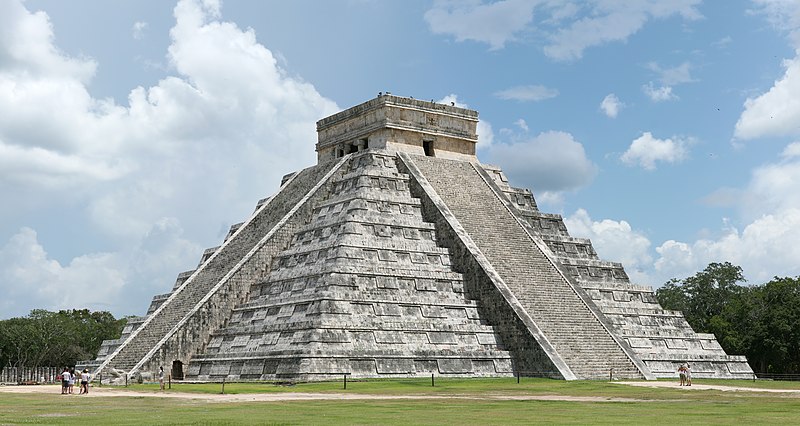Editor’s note: Please welcome architect and catechist Christian LeBlanc, who has long practice teaching sixth graders about the connection between Scripture, art, and sacred architecture. He has graciously agreed to write a series for the Catholic Writer’s Guild. Enjoy!
I was married 24 years ago last month; that’s right, 24 years of wedded bliss. We went to Cancun for our honeymoon. Maybe I should say we went to Yucatan, because we drove ourselves to Chichen Itza for a little day trip. I’d seen photos of the Castillo there, it looked kind of ho-hum: the platform at the top is about 80’ high. The highest pyramid at Giza is about 6 times taller. Back then you could climb to the top; I was going up no matter how mundane it looked from the ground.
It’s a steep stair, with no landings or handrails; not safe by any modern Western standard. I didn’t dare look around until I was at the top, and…wow. There was nothing but infinite flat green scrub as far as the eye could see in every direction. For any Mayan, this was the Top of the World, one step away from heaven. I have never felt higher since I stood on that 80’ artificial mountain.
You may remember the patriarch Abraham was from “Ur of the Chaldeans” in Mesopotamia. Like the Yucatan, Mesopotamia is way flat. It’s no surprise then that the Bronze-Age King Ur-Nammu also built an artificial mountain to get closer to heaven: a ziggurat.
A couple of centuries later, God sent Abram packing off to Canaan. When Abram arrived, he too built a ziggurat: “When they had come to the land of Canaan, Abram…built there an altar to the LORD, who had appeared to him.” OK, so he didn’t exactly build a full-scale ziggurat: he just built a little one, tall enough to get his offering out of the dirt and a bit closer to God up in Heaven.
Years after, God asked Abraham to sacrifice his only son Isaac. Obedient Abraham journeyed 3 days to reach Mount Moriah; a real mountain, much higher than a mere ziggurat. Being so much nearer to God on the mountaintop, did Abraham throw Isaac on the ground and get out his knife? No indeed: he built yet another altar on top of the mountain. Getting up near God isn’t enough. An offering needs to be clear of the Earth as well: near what’s holy; away from what’s sinful.
Solomon’s Temple maintained this sensibility: the mountain raises the building nearer to God; the altar within lifts the offering away from the broken world.
As Judaism’s younger brother, Christianity keeps this tradition. I’ve seen churches on European hills whose main reason for being seemed to be that the height required a church (FYI, that would include Montmartre; La Superga near Torino; Mont St. Michel; the Assumption Church in Lake Bled; and San Giorgio in Portofino). Still today, Catholic churches offer the sacrifice from a raised altar, much as He was once lifted up on a cross. And even if the land is as flat as Mesopotamia, the sacred space surrounding the altar is elevated at least a few steps above the rest of the church.
Readers may enjoy seeing how this content was originally packaged for my 6th-grade Catechism class:


Very interesting. In the 1962 liturgical books, three steps are required to be mounted up to the altar. This makes it challenging to celebrate in the churches that were not designed for it.
Hey IIRC, as a kid at St. Francis de Sales parish in Houma, La. that it was 3 steps down to the baptistry.
Thanks Christian. This is going to be a great series!